Korfball drills
The goal is for each team to score 500x all together in the next 5 tasks. After each assignment there is an intermediate exercise for variety:
- Assignment 1: Walk-through balls: score 120x
- Intermediate task 1: match between3 posts of 5 minutes.
- Assignment 2: Front basket shots from movement: score 80x
- IntermediateAssignment 2: Take 2 minutes of walk-through balls with your group. What is the largest number you score in a row?
- Assignment 3: Short chances with intermediate pass: score 120x . So play in and get back.
- Intermediate assignment 3: which group scores the most goals from 6 meters in 3 minutes.
- Assignment 4: Penalty throws: 100
- Intermediate Assignment 4:
- At each post there is one fixed shooter with a fixed rebounder.
- In each round the shooters, within the time limit, must score one goal.
- If a goal is scored, the ball is held.
- If no goal is scored, within the time, the shooter is out of the game.
- Games are played in the following rounds:
Round 1: 10 seconds.
Round 2: 5 seconds.
Round 3: 3 seconds or 1 chance. - No shooter is changed until all rounds have been played.
- Do all players miss in a round? Then the round will be played again!
- Intermediate Assignment 4:
- Assignment 5: Shots back basket from movement: 80. Rotate posts 180° if necessary.
- The player with the ball has a defender trying to intercept the ball.
- The attacker plays with the 3 others and with as little running as possible tries to pass the ball with the 3 helpers for 1 minute.
- The ball may be in the hands of a player for max 3 seconds.
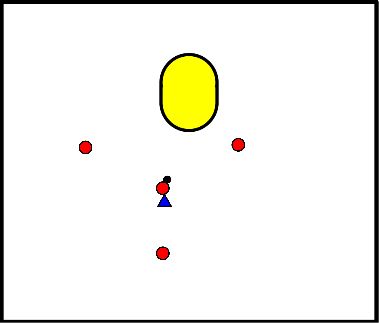
- the back player cuts in to the support as the ball enters the field and gets it played.
- the passer simultaneously runs across the support to the rebound and takes over.
- the support passes the ball to the diagonal player in the break and takes the shot
- If that is not successful, the ball can be passed to the outgoing first rebounder
At that point, there can be doubles/ breakthroughs from both the first and second players and you get opportunities again if the then standing rebounder steps out again or the earlier support makes an action without the ball.
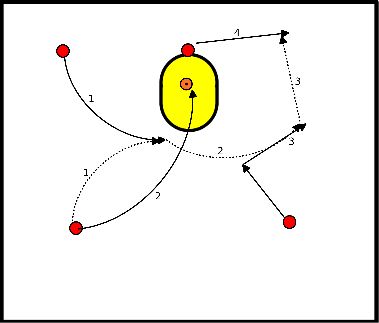
- The first ball is played deep from the front pocket.
- Then the other front comes in and passes the ball.
- The first passer runs across the block to the catch.
- The adjuster runs on the ball side for a through ball to the post.
Alternatively, the ball is played back directly for the distance shot. - The player under the post steps out as soon as the rebound is taken over from the front and ensures that the player with the ball has two points of attack.
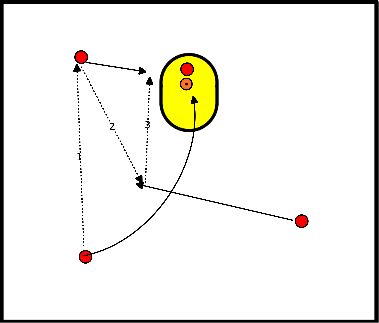
- 2 pawns face each other, ball is passed over, player runs towards the basket.
- Ball is indicated in space and finish through ball.
- Offender runs along and catches the ball.
- Switch positions.
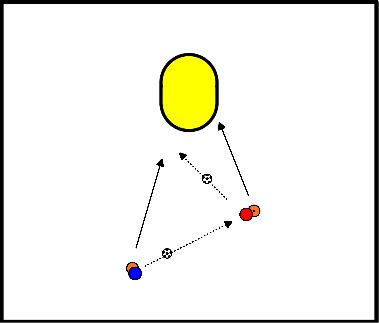
- Blue player with ball plays the ball to outrunning player under the post.
- Then this one runs with it himself, gets the ball back and shoots.
- The front player goes to the back and the back player to the front.
- The red player in the diagonal catches and plays to red in front of the basket.
- This one runs out, gets the ball back and plays back to the running red player, this one shoots and the blue player catches.
- Again, the players switch positions.
Which pair scores 10x first?
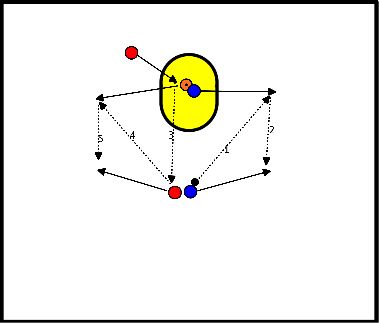
Organization:
Three players per post.
1 player with ball diagonally in front of the basket at 7 meters.
The other player is also diagonally in front of the post.
Three players per post.
1 player with ball diagonally in front of the basket at 7 meters.
The other player is also diagonally in front of the post.
- The player under the basket pulls away making the player with ball the middle player.
- Gets the ball thrown to him from the player in front of the basket. If the arrangement is good, he thus receives the ball a little diagonally.
- This player runs to the post for the catch -rebound-.
- The player in front of the basket comes next to it and gets the ball.
- And comes to shot. Remember to turn in well to the basket with the hips.
We score 10x to the left and 10x to the right. - After the shot, the ball is played out to the first out runner, the catcher now runs out and play begins again.
- Same as above
- Only now the player who threw the ball in front of the basket comes next to it.
- This one does not get the ball but cuts inside and makes a through ball from space without the ball.
10x left and 10x right - Catches the ball himself and plays it to the first runner, the catcher now runs out and the game starts again.
Same as pawn looting, but now you may loot people when you run out of pawns in the middle.
Game rules:
Game rules:
- Teams play against each other.
- Each team has its own basket.
- Instruct which shot is to be made, if this shot is in place then you may take a pawn from the middle
- Are the pawns gone then you may take a person from another team.
Goal
- Which team has robbed the most pawns/ players at the final signal.
or - Which team has robbed all the players at its basket.
In pairs. One declarer and one attacker.
Communicator stands under the basket, attacker stands in front of the basket.
Communicator stands under the basket, attacker stands in front of the basket.
- The attacker runs wide left/right and gets the ball on the outside hand.
- Try to catch and play back with one hand.
- On the 4th pass the attacker is going to take a shot.
- Swap after 2 turns.
- Emphasis on solid passes, and acceleration after re-playing.
Game:
- Team stands in a row at basket 1.
- Participant 1 starts shooting, then participant 2 starts shooting immediately.
- If participant 2 scores before participant 1 then participant 1 is off and goes to basket 2.
- Participant 2 joins behind.
- If participant 1 scores earlier, she goes to the back.
- Participant 3 joins the shooting. If she shoots before participant 2, then she joins at the back and participant 2 goes to basket 2.
- This game continues on all four baskets until there is a winner on basket 1.
Agreements
- You may interfere defensively, but not knock the ball away.
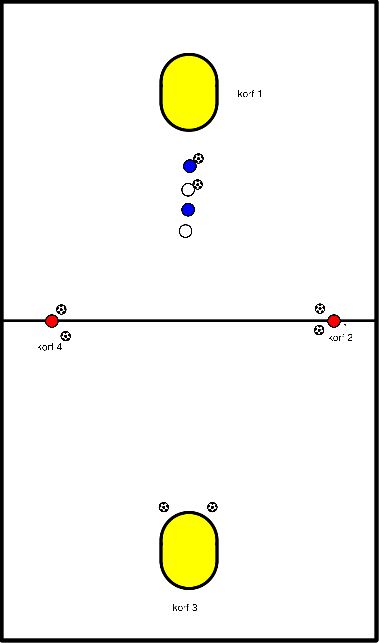
The goal of these drills is for threesomes/foursomes to keep moving at a steady pace and take turns taking a chance to score.
The shots come from all sides of the basket.
The shots come from all sides of the basket.
- Scoring 40 through balls, the shooter catches the ball himself and 1 of the 2 others comes in for a chance. In case of a 4-pointer, the ball can be caught by another player.
- Score 15 dodge balls. When the ball is caught, the third player immediately makes an evasive move and is played. Timing is important.
- 20 distance shots from about 6-8 meters from the basket, again keep moving until you get the ball.
Finally, each player scores 5 penalty shots in a row. The others can stretch in that time if they want.
- This exercise is designed to let the players choose for themselves what they want to improve on.
- Which (improvement) goal, which they have set for themselves, do they want to improve here.
- As a trainer you can steer this by guiding the choice.
- For example: the exercise must have something to do with passing/shooting/attacking/looking etc.








